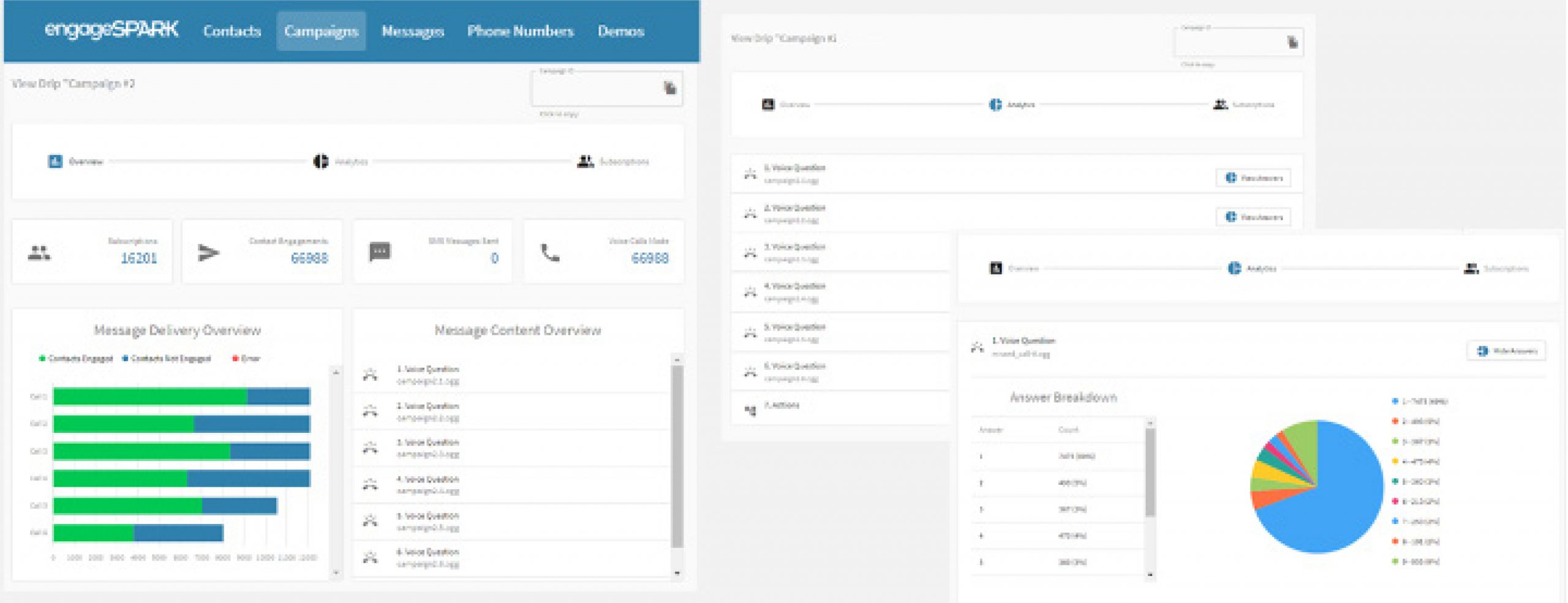THE ULTIMATE GUIDE TO VOICE CALL (IVR) CAMPAIGNS FOR SOCIAL IMPACT PROGRAMS
Best practices from the field how you can build a successful interactive voice campaign for developing and emerging markets.






TABLE OF CONTENTS
- What is IVR?
- IVR cheaper than SMS
- Common use cases for IVR
- Target Audience
- How to create a basic IVR campaign?
- Tips on setting up an IVR campaign
- How to read and interpret results?
- How to test and iterate
- Definition of Terms
IN THIS GUIDE, YOU CAN FIND TOOLS AND STRATEGIES TO:
- Understand the main features and uses of Interactive Voice Response (IVR)
- Make the most out of IVR
- Create an IVR campaign on the engageSPARK platform
- Set up your campaign for best results
- Read and interpret results
- Bonus: How to test and iterate your campaign
WHAT IS IVR?
IVR is short for Interactive Voice Response, the technology that powers interactive automated phone calls, where a person receives a pre-recorded phone call (or calls into a pre-recorded hotline) and interacts with the call by pressing particular keys on their phone’s keypad or by giving spoken responses. With IVR, users can build sophisticated voice call surveys or automated call campaigns.
An IVR campaign is a set of pre-recorded instructions or questions that solicit a response from a person at the other end of the line. These responses will be saved as data, which the campaign creator can analyze both during and after the campaign. These reports typically include information on call lengths, keypresses, and engagement, which are all available in real-time.
There are many kinds of IVR campaigns, but most of them have a common purpose: to collect data efficiently.
Higher Response Rates to Surveys
Generally, IVR campaigns have higher response rates than SMS campaigns. For example, a typical automated call survey may get a 25-75% response rate, while an SMS survey might only get a 5-15% response rate. IVR campaigns receive more responses for several reasons. Firstly, IVR is an asynchronous form of communication; IVR survey respondents are answering questions during a single, ongoing call. SMS, conversely, is an asynchronous form of communication; SMS survey respondents receive a question, need to type a reply, send it, wait to receive the next question, and so on. Put simply, an IVR survey has much more of a real-time feeling for respondents than the back and forth feeling of SMS. If a person doesn’t reply to an SMS survey question right away (which is common with SMS; people read an SMS on their phone and then check other things), then it is much less likely that they’ll return to the SMS to reply. Phone calls don’t have the same kind of issue. Secondly, IVR is always free for respondents. Receiving a phone call is free in practically every country in the world, including every developing and emerging market. Making SMS free for respondents is not always easy because it requires acquiring a toll-free (also called “reverse-billed” or “free to the end-user” [FTEU]) number for respondents to send their replies to.

An Inclusive Mode of Communication
IVR campaigns are more inclusive and broadly representative because anyone, regardless of literacy level, can participate in voice programs. SMS covers smaller ground because factors such as low literacy levels and varying language competencies have to be considered. With IVR, campaign creators can send voice messages in the recipients’ native language and engage with people who cannot read.
Richer Content
With IVR, disseminating information becomes more personal and accessible. Voice messages have a lot more dimensions than text messages. With voice, you can employ tone, pacing, and mood. Your voice talent can also embody different personalities. For example, you may want to record a female’s voice for a women’s empowerment campaign.

Richer Data
Aside from keypresses, IVR also allows people to provide spoken responses to questions. Audio messages provide richer data and therefore more room for deeper analyses. As mentioned earlier, compared to text messages, there are more dimensions to voice communication. SMS does not reflect pauses, emotions, or tone. With IVR, campaign creators can analyze the tone of the recipient’s voice, their pauses, and the emphasis they place on specific words.
IVR IS OFTEN CHEAPER THAN SMS!
- An SMS is limited to 160 characters (or 70 characters for Unicode languages such as Chinese, Arabic, Hindi, etc.). You can pack a lot more into one minute of an IVR call than in a single SMS; so even if a single SMS is much cheaper than one minute of IVR, a call asking five questions might be cheaper than an SMS survey asking five questions.
- With SMS, respondents can only provide answers by texting back. Although SMS surveys can be set up to allow respondents to send messages for free, the expense still falls on the campaign creator.
- Because SMS response rates are much lower than IVR, you end up sending (and paying for) a lot of unanswered SMS. You are not charged for unanswered calls, so IVR surveys don’t have that large additional cost for unanswered surveys. In some cases, respondents will hang up towards the beginning of a call, adding additional cost to IVR.
- Call retries are free, so following up on respondents will have no cost. Free follow-ups are not possible with SMS since the campaign creator would have to pay for every message sent.
- Since IVR campaigns have higher response rates, campaign creators get more value for their money and often a lower fee per completed survey.
- IVR surveys reduce the need for manpower since organizations do not have to employ a team whose sole job is to make or answer calls. This also means that program and M&E officers can focus on their core tasks!
- SMS surveys entail setup and monthly fees because they require an SMS phone number, which, depending on the country, can make SMS much more expensive.
COMMON USE CASES FOR IVR

Monitoring and Evaluation

Information Dissemination

Education

Data Collection

Crisis Hotline
BUT FIRST, LET’S TALK ABOUT YOUR TARGET AUDIENCE

Language
We recommend that you compose and record messages in your recipients’ native or first language. You may also record several sets of messages in different languages and provide an option at the beginning of the call.
Literacy Level
Do you plan to send an SMS to notify your recipients that an IVR call is coming? Consider that not everyone has access to education, especially in some developing and emerging markets. We recommend identifying key group members in the community who can spread the word about the campaign on the ground.
Cultural Nuances
In the past, we have experienced low response rates simply because we called people at the wrong time. We learned that timing is an important factor in launching campaigns. We encourage our users to think about the end-user’s schedule. What time do they work? Do they sleep early? Do they have religious or cultural rituals that they need to perform at a specific time? Running A/B tests to determine which call times lead to the highest response rates is also easy with IVR – and critical to do.
HERE’S HOW TO CREATE A BASIC IVR CAMPAIGN USING ENGAGESPARK
Step 1
Step 2
Step 3
Step 4
Tips on writing:
• Don’t just plan for questions. Plan for answers, too. • Always introduce yourself at the beginning of the call and explain why you are calling. • At the end of the campaign, make sure that you have a closing message.
How to set up a campaign:
There are two ways to add your messages or questions. You can: • Record on the platform. • Record offline and upload your audio to the platform.
How to subscribe contacts:
You can choose individual contacts, groups, or segments. • Individual contacts will be added one by one. • Groups are sub-categories of contacts in your database that the user creates. • Segments are groups of contacts that have similar characteristics based on certain configurable conditions. Segments are similar to filtered contacts.
Here are some important reminders:
• Set up configurable call-time windows. This is an important step, especially for IVR, since you don’t want to call people in the middle of the night or when they are busy. • Lastly, select your preferred caller ID.
TIPS ON SETTING UP AN IVR CAMPAIGN
Set up an opt-in process based on the target audience.
Determine how respondents can sign up to a campaign by considering the following: Do you have an existing database? If yes, did the people on the list agree to take part in your campaigns? If you don’t have an existing database, how can you facilitate opt-ins? You may ask your respondents to opt-in via: • SMS – They can text a keyword to a number that will automatically subscribe them to a campaign. • Missed Calls – They can call a number and hang up immediately to signal to the system that they are interested. This doesn’t have to be a toll-free number since they won’t be charged for missed calls.
Include Instructions.
If asking questions, let the end-users know how they will answer questions. For example, “We’ll be asking you some questions on this call. You will answer by pressing numbers on your phone. To show us you understand, press the number 1 on your phone now to continue.” While this might sound unnecessary, it’s important. Many end-users in developing and emerging markets have never interacted with an IVR call before. Explaining this at the beginning of the call is, therefore, critical. Similarly, if asking questions, don’t just ask people to “press” a number; instead, ask them to “press the number X on [their] phone.” For example, when asking a question, don’t say, “Press 1 for yes, press 2 for no.” Instead say, “Press the number 1 button on your phone for yes, press the number 2 button on your phone for no.” This phrase, “Press the number X button on your phone” leads to higher response rates.
Record high-quality audio.
The best place to record messages is a quiet room with few flat surfaces to reduce echoing. You may record your audio clips in a professional studio or in a soundproof booth. If you don’t have access to these facilities, a practical tip is to record your messages under a blanket or inside a closet full of clothes using your phone or earphones to mask the noise around you.
Choose the right language.
For both SMS and IVR, it is best to use the respondents’ native language.
Mix SMS and IVR.
There are several reasons for failed calls. It could be that respondents are preoccupied, asleep, or are simply on silent mode. Considering your target audience, try mixing up SMS and IVR. Try sending SMS messages to those who don’t answer phone calls or try calling people who don’t answer SMS surveys.
You’re not limited to objective questions.
With IVR, you can ask questions that may solicit longer answers through spoken responses, which can be accessed at any time in the engageSPARK platform.
Send an SMS before calling.
Give your respondent a heads-up by sending them a text. Mention the phone number that the IVR call will come from so they expect the call and know to pick up. Also, if sending an IVR survey, use phrases like, “You have been selected to take a survey” to make people feel special and more likely to participate.
Offer incentives.
Send mobile credits to encourage respondents to complete a survey. This can be in the form of airtime top-ups (prepaid mobile phone credits). Click here to find out how to use the engageSPARK platform to automatically send airtime top-ups to respondents immediately after they complete a survey.
Set up automated call retries.
Some people miss your call despite prior notifications. This can be addressed by setting up call retries on the engageSPARK platform. This step is particularly useful if there are thousands of contacts enrolled in the campaign. Some people miss your call despite prior notifications. This can be addressed by setting up call retries on the engageSPARK platform. This step is particularly useful if there are thousands of contacts enrolled in the campaign.
HOW TO READ AND INTERPRET RESULTS

BONUS! HOW TO TEST AND ITERATE
Do a pilot run.
You can test a campaign with a small portion of your database to see how they respond to specific questions. This is also an opportunity to assess other factors that may influence the campaign, such as timing and pacing.
A/B test.
You can launch two or more campaigns for different contact groups or segments. Compare the responses and analyze why one campaign might have received more responses.
Iterate. Iterate. Iterate.
Pay attention to the results of your campaign and iterate accordingly until you are happy with them.
DEFINITION OF TERMS
IVR
Interactive Voice Response (IVR) is a tool that allows call recipients or incoming callers to go through an automated phone system and respond to prompts via keypresses or spoken responses. An IVR campaign is a set of pre-recorded instructions or questions that solicit a response from the other person on the line.
SMS
SMS stands for Short Message Service, a type of text message typically used for mobile messaging. SMS messages are usually limited to 160 alphanumeric characters (or 70 characters for messages containing Unicode characters, such as Chinese, Arabic, Hindi, etc.).
Campaign
A campaign is a series of messages you send to a target audience with specific objectives. There are several types of campaigns that you can run with SMS and voice. Some examples are SMS blast campaigns, SMS surveys, IVR surveys, and drip campaigns.
Drip Campaign
A drip campaign is a scheduled set of messages, which can be a combination of one-way SMS, SMS questions, voice messages, and voice questions.
Airtime Top-ups
Airtime top-ups can be in the form of mobile credits or mobile data. You may use airtime top-ups as an option to incentivize people to respond to your campaigns.
Users
This is you! A user is someone who is directly using the platform.
End-users
When we say “end-users”, we are referring to your campaign recipients, respondents, or beneficiaries.

